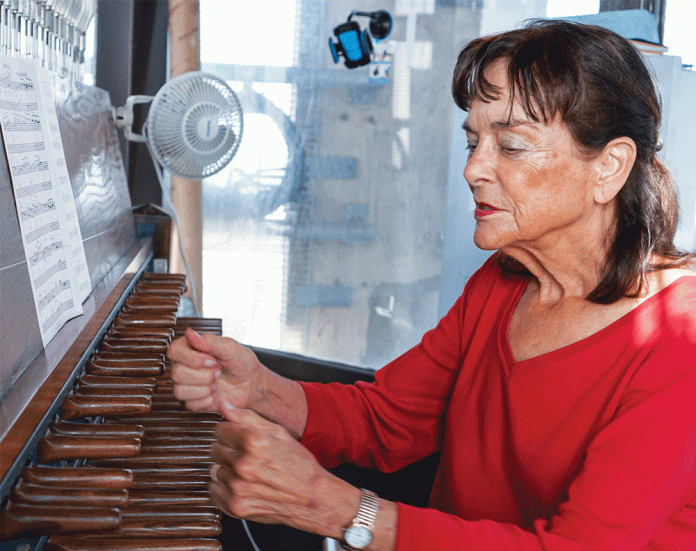Gwendolyn Wu
Editor-in-Chief
Carillonist Margo Halsted takes the elevator up to Storke Tower’s observation deck every Monday morning, climbing a few short flights of stairs after reaching the top to overlook the University of California, Santa Barbara’s campus, the Pacific Ocean, and the Santa Ynez Mountains.
Just prior to 7:45 a.m., Halsted unlocks a glass-walled room nearly 175 feet above the ground. As she sets down her folder of sheet music, she surveys the room. In the minutes before her call time, she slips ring-like pads on her hands before tinkering with a series of pulleys.
At 7:45 a.m. sharp, the music begins. While bleary-eyed students below shamble towards class, in the tower Halsted is awake and moving. Her fists begin striking large wooden keys. Haunting tunes from “The Phantom of the Opera” chime from the 61-bell carillon, the crown jewel of Storke Tower.
“It’s almost 50 years old,” said Halsted, who has taught carillon as an adjunct professor in the music department since 2008.
Some days, Halsted plays one of her own compositions. Other days, the bells toll pop culture hits, like Rick Astley’s “Never Gonna Give You Up” or the Pokemon theme song. These are all songs she has chosen to ring from the highest point on campus.
“I know what students want to hear,” said Halsted knowingly. “I ask my students what they’d like to hear and I arrange them, or they do the tune.”
The carillon (pronounced CARE-il-lawn), at first glance, is complex. It resembles a Da Vinci-like experiment with its pulleys, wooden keys and pedals, and 61 bronze bells ranging from a mere 18 pounds to approximately 2.5 tons. The UCSB bells span five octaves. Inscriptions run along many bells, with the largest bearing the words “Fiat Lux,” the university’s motto.
Despite all of its impressively bulky parts, the carillon is simply a larger version of a piano, played with loosely-balled fists instead of deft fingers. For heavier keys, the musicians use correlating foot pedals to strike the bell. Pulleys connect the keys and pedals to clappers, which strike the bells. Playing the carillon requires the whole body, Halsted said.
Storke Tower’s carillon, a Petit & Fritsen model, was gifted to the university in 1969. A motor plays the carillon at the beginning of each hour, timed to avoid interfering with most hour-long classes. This year, UCSB will add an automatic play system that will allow players to record a variety of songs to be played hourly.
While Halsted is typically the tower’s sole occupant from 7:45 a.m. to 8 a.m. on Monday mornings, a few others occasionally join her. Undergraduate and graduate students can take Music 24 or 124, respectively the Carillon and Advanced Carillon classes. Piano fundamentals are essential.
“The sounds are striking and beautiful, and you get to see all these bells from the very biggest 2-ton bell to the smallest bell that weighs just a few pounds,” wrote Iris Xie, a fourth year economics and accounting major taking Halsted’s carillon class.
Her students begin by practicing on an imitation carillon keyboard in one-on-one sessions. While it’s not tolling the bells, it helps reinforce technique and “the idea of playing musically,” said carillon student David Hwang. Afterward, students get a chance to play towering above UCSB.
“Being able to make music while having a beautiful 360º view of the campus is unbelievable,” Hwang, a doctoral student in materials engineering and science, wrote in an email to The Bottom Line. “The bells offer a majestic sound, and the tower has the best views in the entire county of Santa Barbara.”
In 2015, Hwang joined Halsted. What were his first thoughts upon sitting down on the carillon bench? “I’m on top of the world, and everyone can hear me playing!” he wrote.
Since picking up the instrument, Hwang has played at 10 carillons in the U.S. and Europe. His favorite songs include “Gaudi’s Chimneys” by John Courter, “Hallelujah” by Leonard Cohen, “When You Wish Upon a Star” from Disney’s Pinocchio, and what is likely a campus favorite: the Game of Thrones theme song.
Halsted and her students play formal recitals, including traditional and pop songs every year, accompanied by other students in the music department. Some of Halsted’s students have gone on to be carillonneurs and carillonists themselves, passing national exams to do so.
Over several decades, Halsted has played carillons seemingly everywhere, including Stanford’s Hoover Tower for a few years and the University of Michigan’s Burton Memorial Tower. In a previous interview with The Bottom Line, Halsted said that one of her favorite recitals was in Bruges, Belgium, where she played for an estimated 3,000 people in two markets. Another trip in 2000 saw her playing at The Young Men’s Christian Association (YMCA) in Jerusalem.
Home for now, however, is the glass room in Storke Tower. At 8:01 a.m., she’ll slip sheet music back into her folder, slide the pads off her hands and rest up a bit, and then work on campus before the long drive back to her home in Pasadena.

















